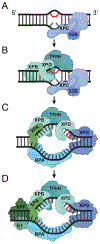Mechanism of action of nucleotide excision repair machinery
- PMID: 35076656
- PMCID: PMC9275815
- DOI: 10.1042/BST20210246
Mechanism of action of nucleotide excision repair machinery
Abstract
Nucleotide excision repair (NER) is a versatile DNA repair pathway essential for the removal of a broad spectrum of structurally diverse DNA lesions arising from a variety of sources, including UV irradiation and environmental toxins. Although the core factors and basic stages involved in NER have been identified, the mechanisms of the NER machinery are not well understood. This review summarizes our current understanding of the mechanisms and order of assembly in the core global genome (GG-NER) pathway.
Keywords: DNA synthesis and repair; nucleotide excision repair; structural biology.
© 2022 The Author(s). Published by Portland Press Limited on behalf of the Biochemical Society.
Conflict of interest statement
Competing Interests
The authors declare that there are no competing interests associated with the manuscript.
Figures


References
-
- Lindahl T and Wood RD, Quality control by DNA repair. Science, 1999. 286(5446): p. 1897–1905. - PubMed
-
- Cleaver J, Defective repair replication of DNA in xeroderma pigmentosum. nature, 1968. 218(5142): p. 652–656. - PubMed
-
- Marteijn JA, et al., Understanding nucleotide excision repair and its roles in cancer and ageing. Nature reviews Molecular cell biology, 2014. 15(7): p. 465–481. - PubMed
-
- Tornaletti S and Hanawalt PC, Effect of DNA lesions on transcription elongation. Biochimie, 1999. 81(1-2): p. 139–146. - PubMed
Publication types
MeSH terms
Substances
Grants and funding
LinkOut - more resources
Full Text Sources

